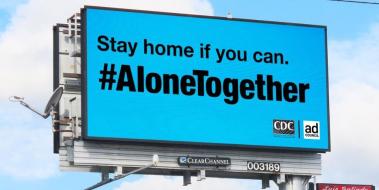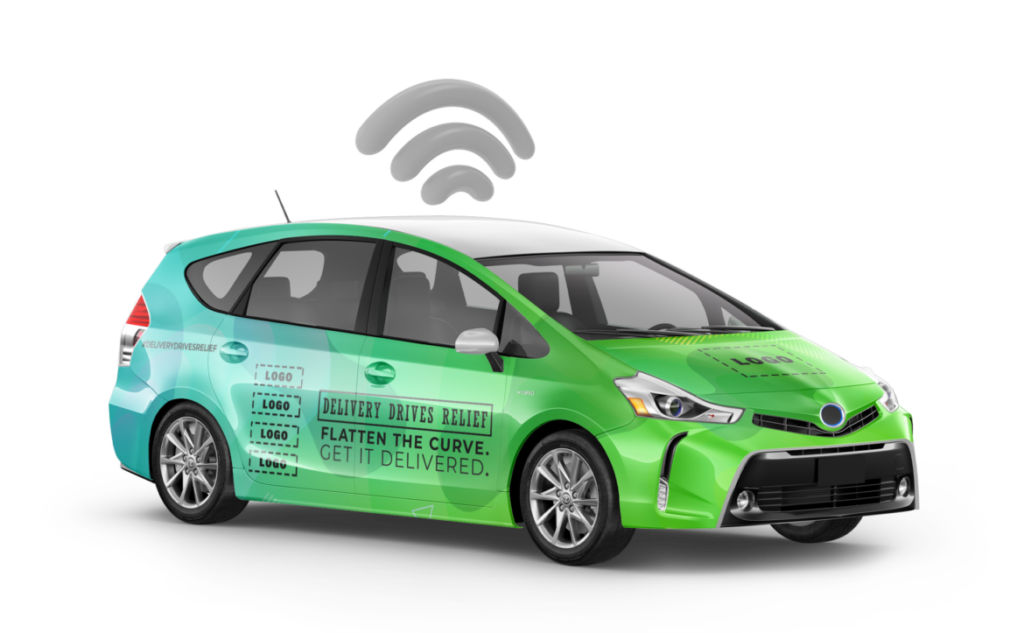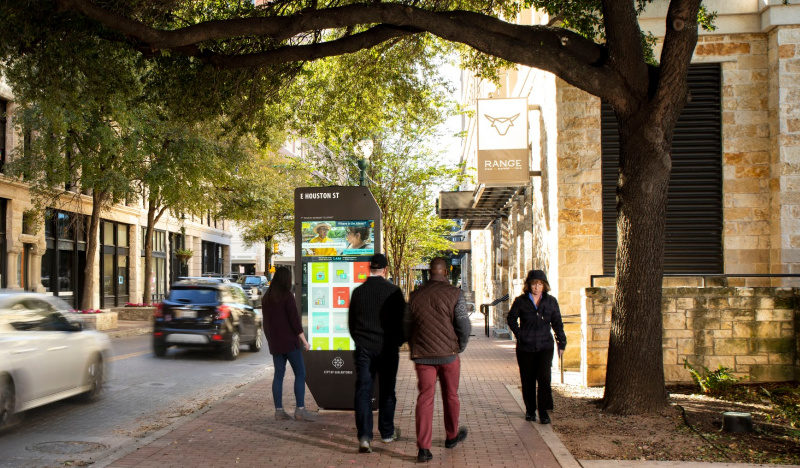When COVID-19 stay-at-home mandates reduced the number of commuters, travelers, and event-goers exposed to out-of-home messages in urban centers, OOH agencies quickly adapted. They posted public health messages, supported small businesses, and thanked the frontline heroes in hospitals. They also provided data and insights to help brands understand some of the changes in audience movements and behaviors. Here are a few examples:
Amplifying the Ad Council’s COVID-19 Messaging
In March, the Ad Council, White House, U.S. Dept. of Health and Human Services (HHS), and Centers for Disease Control and Prevention convened OOH industry leaders to bring critical COVID-19 safety messaging to the American public.
By donating ad space on premium out-of-home advertising billboards, kiosks, and car tops, the OOH industry helped amplify the important Ad Council messages that were also being broadcast on TV and promoted through social media.
OAAA (Out-of-Home Advertising Association of America) published a landing page from which members downloaded the Ad Council’s creative assets for COVID-19 campaigns. While each OOH company provided customized support, all Ad Council’s creative assets were designed to drive audiences to www.coronavirus.gov, the centralized information resource from HHS and the CDC.
The Out-of-Home Division of Circle Graphics donated printing and placement services to get the Ad Council’s creative assets in markets that have limited availability of digital OOH signs.
“The American public looks to the Ad Council in times of crises, and Circle Graphics hopes getting printed materials strategically placed by our partners Clear Channel, Lamar Advertising, Outfront and others extends the reach of these life-saving messages,” said Rod Rackley, president of Out of Home at Circle Graphics.

“Out of home has historically played an essential role in informing our communities and residents on how to stay safe during times of uncertainty and crisis,” said Scott Wells, Chief Executive Officers, Clear Channel Outdoor Americas.
Other OOH companies that supported Ad Council messaging included Firefly, Intersection, Lightbox, Octopus Interactive, and ReachTV.
Firefly supported COVID-19 work across their platform on digital screens topping ride-share vehicles and taxis in major markets.
Intersection ran the creative on their assets in New York City and worked with the Ad Council to launch multiple distribution efforts nationally.
The Lightbox OOH video network ran public service announcements across their video screens in malls across the U.S.
Octopus Interactive activated its nationwide network of digital displays inside ride-share vehicles to deliver the Ad Council campaign’s ads to passengers.
ReachTV launched the Ad Council’s COVID-19 public service announcements on TVs in 90 different airports and posted videos on the ReachTV Celebrity Fan pages on Facebook and Instagram.
Uber activated its cartop OOH ad space technology to bring the campaign’s messaging to multiple markets across the U.S.
“We’re incredibly grateful to all of our extraordinary out-of-home partners who are ensuring that these critical messages are being seen by the American people,” said Lisa Sherman, president and CEO of the Ad Council.
Using Vehicle Advertising to Support Gig Workers
Wrapify is a fast-growing OOH company that enables gig-economy workers to earn extra money by displaying ad messages on cars they drive for ride-share and delivery services such as Uber, Lyft, GrubHub, and Postmates.

On March 24, Wrapify announced an 8-week “Delivery Drives Relief” campaign to help gig economy workers who transitioned from driving passengers to delivering meals, groceries, and supplies to millions of home-bound workers and their families. While ride-share use dropped as much as 70% during the COVID-19 shutdown, drivers hoped to replace some of that income by making deliveries for restaurants and other local businesses.
The wrap graphics Wrapify designed for brand partners encouraged people to “Flatten the Curve: Get It Delivered.” The campaign was conducted on 1,900 gig-work/delivery vehicles in cities in which restaurants were hit hard by the COVID-19, such as Las Vegas, Atlantic City, and Savannah, Georgia.
Promoting Hyper-local OOH Advertising
Billups is an advertising technology company that uses data analytics to help OOH and DOOH advertisers plan and measure campaigns in a manner that meshes with digital advertising campaigns.
In April, they published research about how COVID-19 shutdowns had affected exposure to OOH campaigns. The study found that while airports, restaurants, hotels, malls, and other sites experienced significant decreases in foot traffic, essential businesses such as grocery stores, gas stations, pharmacies and general merchandise stores were seeing higher numbers of visitors.
To enable brands to stay connected to their audiences, Billups recommended shifting OOH ads from traditional high-traffic sites such as highways and urban transit platforms to hyper-local OOH sites in neighborhoods.
For example, Billups suggested that brands place empathetic COVID-19 messaging on neighborhood street furniture or on signs near grocery-store entrances. They even proposed reaching consumers at home through printed door-hangers or advertising inserts with pizza, restaurant takeout, or Amazon delivery boxes.
Helping Local Businesses
Some OOH companies, such as do-it-outdoors promoted their ability post brand messages on mobile hand-washing stations or trucks used to deliver products to neighborhoods.
During the week of April 13th, they also ran three of their largest mobile billboard units along routes that passed every grocery store, healthcare clinic, hospital, and pharmacy in York, PA. The graphics featured eye-catching ‘Thank You’ messages targeted toward essential local grocery and healthcare workers.

Orange Barrel Media and its sister company IKE Smart City donated airtime on their digital signage platforms to local businesses and non-profit groups in 18 major cities.

“What would our cities be without the local and independent merchants and restaurants, arts organizations, and non-profits that define the culture of our communities? These organizations not only employ more than 50% of US workers, they enrich our lives and make our cities unique. We must support one another as we navigate the devastating effects of COVID-19,” said Pete Scantland, CEO of Orange Barrel Media and IKE Smart City. “Our mission is to utilize our media platform to improve lives in cities, and we are committed to leveraging our assets to help those who are suffering during this time.”
Lessons Learned
As the COVID-19 crisis intensified in March, brands had to quickly shift their ad messaging to be more empathetic to consumers whose lives have been disrupted. OOH advertising companies demonstrated how quickly they could help brands pivot. They also showed how OOH advertising can be a measurable, real-world component to social-media and other other online marketing campaigns.
While many brands cancelled previously scheduled OOH campaigns for March and April, OOH companies encouraged them to plan ahead and reserve prime OOH space for the late summer and fall months as business gets back to normal.
Recommended Reading
The Importance of Brand Awareness During a Crisis.
This post on Medium explains why it’s important for companies to maintain brand awareness and trust during a crisis.
Hyperlocal is the New High Profile
In an OAAA Thought Leadership post, Jan Jeff of Billups notes that “The traditional experience of OOH has completely changed in our current situation. It is normally seen as something to be experienced concurrently, with billboards that reach many people simultaneously, and on a large scale. But, with the seclusion of audiences to their homes and neighborhoods, hyperlocal, which features types of OOH media like bus shelters, street furniture, transit, package inserts, kiosks, and more, all have a unique ability to reach audiences on a more personal level.”
